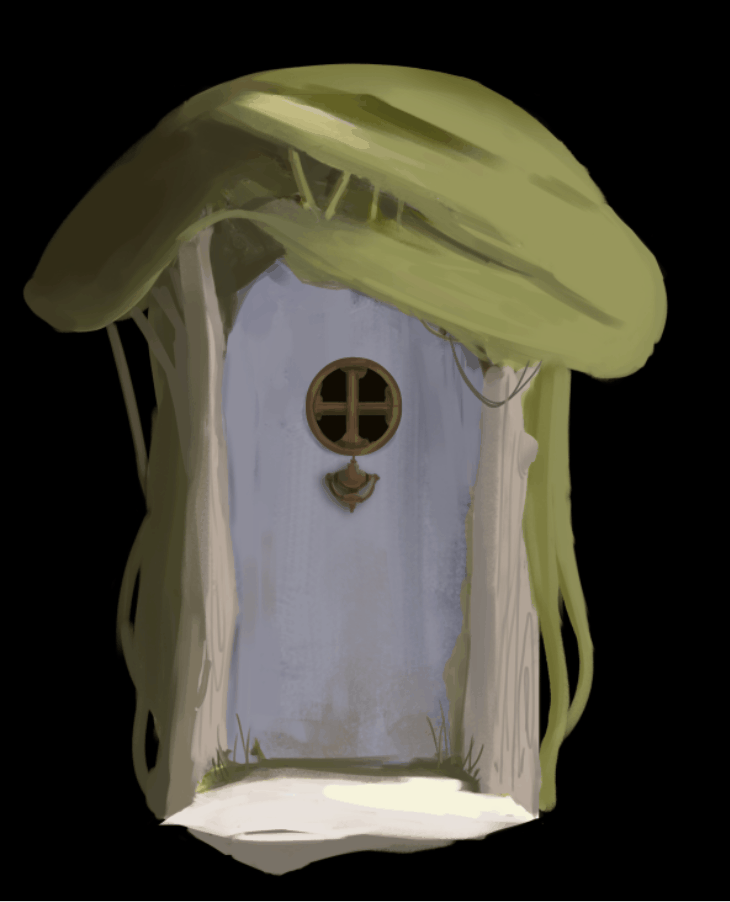O'pendor
Team: Team 40
Role : Game Designer & Art Lead
Genre: Puzzle Game
Project Summary
This is a puzzle game centered around unlocking doors, which I worked on as part of a Game Jam. Players must use their intelligence and problem-solving skills to open all the doors and progress through the game.
Tool
-
Unity
-
Photoshop
-
Miro
-
Jira
-
Discord
Procees Work
Pre-production:
Design challenge: design a new and unique gameplay experience that centers around one underexplored action or verb.

After getting to know each other within our group, I quickly conducted a brainstorming session for game ideas based on the fact that our team had multiple members skilled in game art.
Based on everyone's brainstorming ideas, my group members and I agreed on using the verb "open" as our core mechanic. We decided to incorporate doors into a puzzle game, as using doors as a primary element could create an engaging experience for players to explore.
At the same time, we took inspiration from Monsters, Inc. and initially decided that we could design doors with different styles, shapes, and functions. This approach would not only enrich the gameplay but also allow our art-focused team members to fully showcase their strengths.


Design Process:

Otherworldly Monsters:

Next, I created several concept sketches to explore different visual styles for various game screens and to illustrate the fundamental mechanics of the doors. These sketches helped in visualizing how the game would look and function while providing a foundation for further development:
Each door will be linked to different otherworldly monsters, adding variety and depth to the game's mechanics and visual design.
Horror Cyberpunk:

Different doors will have glowing liquid attached to them, enhancing the eerie and mysterious atmosphere of the game.
Post-Apocalyptic Wasteland:

The doors will have a worn and dilapidated appearance, adding to the game's unsettling and immersive atmosphere.
Next, based on our group discussion, we decided that door interactions would be linked to specific items.
To support this idea, I designed concept sketches for doors with different styles and created corresponding interactive items that players would need to use in order to interact with each door:
Treehouse Door: The player needs to find an apple that a small animal desires. Once they give the apple to the animal, the door will open.

Winter Door: The player must pick up a shovel buried in a snow pile and clear the snow. Once the snow is removed, the door will appear, allowing the player to open it.

Straw House Door: The player must find a straw hat hidden on the roof and return it to the scarecrow. Once the scarecrow receives its hat, it will move away from the door, granting access.

Ink Wash Door: The player needs to use a brush to transform the water door into an ink door, making it functional.

Monster Door: The player must adjust the lanterns near the door to match the correct colors corresponding to the monster. When all the colors are set correctly, the monster attached to the door will disappear, allowing the player to proceed.


For the main menu design, I wanted to emphasize the core concept of our game—doors with different styles.
To achieve this, I designed a main door composed of fragmented pieces of various door styles, visually representing the diversity of the in-game doors. Additionally, I used different fonts for the game title to further reinforce the idea of variety and uniqueness.

In the second version, I redesigned the two buttons to visually correspond with the doors and the game's logo, making the main menu more engaging and cohesive with the overall theme.



To make the puzzle more challenging, I designed an apple that blends into the background, making it harder for players to spot and adding an extra layer of difficulty to the gameplay.
Unfortunately, after playtesting, we discovered that the original color choice made it too difficult for players to notice or interact with the mouse properly.
As a result, I adjusted the color to a standard red
For the treehouse environment, I designed a scene featuring the entrance of the treehouse along with a staircase to guide the player's attention naturally. Additionally, I included a cabinet to enhance the sense of everyday life, making the environment feel more immersive and lived-in.


I designed a cute little mouse that stands in front of the door, acting as an obstacle.
-
Before receiving an apple from the player, the mouse has a serious expression, refusing to move.
-
Once it gets the apple, the mouse’s expression changes into a cheerful smile, adding a charming and rewarding moment for the player.
For the treehouse design, I chose to create a stone door to evoke a greater sense of mystery for the player. To make the door feel less rigid and monotonous, I added a window and a door knocker, enhancing its visual appeal and making it more interactive. The darkness inside the window is meant to spark the player's curiosity, encouraging them to explore what lies beyond.
In the first version, I initially placed the treehouse behind the doorframe to create a stronger sense of depth. At the time, I also felt that this color arrangement made the scene more visually harmonious. However, since the design needed to align with the doors created by other team members, I later adjusted it to ensure consistency across the game.



In the second version, I expanded the treehouse’s structure, making the entire door feel like a self-contained, standalone design. This change gave it the appearance of a floating island, enhancing the fantasy atmosphere and making the door feel more distinct and visually engaging within the game world.
4o
Final Design:

